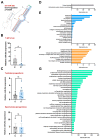miR-29a Is Downregulated in Progenies Derived from Chronically Stressed Males
- PMID: 37762407
- PMCID: PMC10531283
- DOI: 10.3390/ijms241814107
miR-29a Is Downregulated in Progenies Derived from Chronically Stressed Males
Abstract
Recent research has provided compelling evidence demonstrating that paternal exposure to different stressors can influence their offspring's phenotypes. We hypothesized that paternal stress can negatively impact the progeny, altering different miRs and triggering different physiological alterations that could compromise offspring development. To investigate this, we exposed zebrafish male siblings to a chronic stress protocol for 21 days. We performed RNA-sequencing (RNA-seq) analyses to identify differentially expressed small noncoding RNAs in 7-day postfertilization (dpf) larvae derived from paternally stressed males crossed with control females compared with the control progeny. We found a single miRNA differentially expressed-miR-29a-which was validated in larva and was also tested in the sperm, testicles, and brain of the stressed progenitors. We observed a vertical transmission of chronic stress to the unexposed larvae, reporting novel consequences of paternally inherited chronic stress at a molecular level. The deregulation of mi-R29a in those larvae could affect relevant biological processes affecting development, morphogenesis, or neurogenesis, among others. Additionally, these disruptions were associated with reduced rates of survival and hatching in the affected offspring.
Keywords: RNA-seq; behavior; chronic stress; hatching rates; malformations; offspring; small-RNAs; survival.
Conflict of interest statement
The authors declare no conflict of interest.
Figures





Similar articles
-
Elevated paternal glucocorticoid exposure alters the small noncoding RNA profile in sperm and modifies anxiety and depressive phenotypes in the offspring.Transl Psychiatry. 2016 Jun 14;6(6):e837. doi: 10.1038/tp.2016.109. Transl Psychiatry. 2016. PMID: 27300263 Free PMC article.
-
Paternal effects in a wild-type zebrafish implicate a role of sperm-derived small RNAs.Mol Ecol. 2020 Jul;29(14):2722-2735. doi: 10.1111/mec.15505. Epub 2020 Jun 24. Mol Ecol. 2020. PMID: 32525590
-
Stress decreases spermatozoa quality and induces molecular alterations in zebrafish progeny.BMC Biol. 2023 Apr 3;21(1):70. doi: 10.1186/s12915-023-01570-w. BMC Biol. 2023. PMID: 37013516 Free PMC article.
-
Role of small RNAs harbored by sperm in embryonic development and offspring phenotype.Andrology. 2023 May;11(4):770-782. doi: 10.1111/andr.13347. Epub 2022 Dec 2. Andrology. 2023. PMID: 36417503 Review.
-
Paternal programming of offspring cardiometabolic diseases in later life.J Hypertens. 2016 Nov;34(11):2111-26. doi: 10.1097/HJH.0000000000001051. J Hypertens. 2016. PMID: 27457668 Free PMC article. Review.
Cited by
-
Early stress exposure on zebrafish development: effects on survival, malformations and molecular alterations.Fish Physiol Biochem. 2024 Aug;50(4):1545-1562. doi: 10.1007/s10695-024-01355-0. Epub 2024 May 14. Fish Physiol Biochem. 2024. PMID: 38743196 Free PMC article.
-
Experimental PTSD Models in Zebrafish: A Systematic Review of Behavioral, Neurochemical, and Molecular Outcomes.Biology (Basel). 2025 Apr 23;14(5):456. doi: 10.3390/biology14050456. Biology (Basel). 2025. PMID: 40427646 Free PMC article. Review.
-
Temperature and photoperiod stress in zebrafish larvae: impacts on development, gene regulation and PGC migration.Fish Physiol Biochem. 2025 Sep 3;51(5):156. doi: 10.1007/s10695-025-01568-x. Fish Physiol Biochem. 2025. PMID: 40900250 Free PMC article.
References
-
- Schreck C.B., Tort L. The Concept of Stress in Fish. Fish Physiol. 2016;35:1–34. doi: 10.1016/B978-0-12-802728-8.00001-1. - DOI
MeSH terms
Substances
Grants and funding
LinkOut - more resources
Full Text Sources
Molecular Biology Databases

